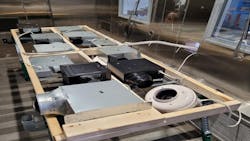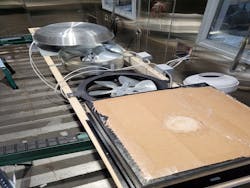A Deep Dive into Interoperability Testing for Residential Fans with Advanced Function Circuit Breakers
While the number of residential fires has been significantly reduced over the last 20 years, the National Fire Protection Association reports there remain more than 45,000 fires related to electrical failure or malfunction every year. The fire services and researchers will tell you the way homes and furniture are built these days provide for faster flashover where the time to escape these fires has dropped from 17 minutes to 4 minutes over 30 years. This indicates a critical need to provide solutions to prevent these fires and the loss of life and property.
The growth in locations requiring electrical protection in homes using advanced function circuit breakers, as required within the National Electrical Code®, has prompted some to ask whether these breakers will function only during a hazardous condition, but not work during standard operating conditions. To test this out, the National Electrical Manufacturers Association and Schneider Electric are announcing the results from extensive testing conducted on residential fans and their interoperability with AFCIs, GFCIs, and dual function circuit breakers.
Per the Business Research Company, the residential fan market size alone has grown steadily in recent years and is expected to grow from $9.94 billion in 2023 to $10.35 billion in 2024.
The types of residential fans reviewed during testing cover attic ventilation, bathroom exhaust, and radon gas removal fans. An advanced function circuit breaker is defined as an arc-fault circuit interrupter (AFCI), ground-fault circuit interrupter (GFCI), or a dual function (DF) circuit breaker that incorporates both technologies. All advanced function circuit breakers also provide thermal magnetic circuit breaker protection.
Interoperability Test Program
A test program was developed and completed to determine any concerns on the interoperability of residential fans with advanced function circuit breakers. The test protocol used leakage current monitoring to determine if the DF circuit breaker tripped on arc fault, ground fault, or thermal magnetic. A variety of manufacturers and types of fans were evaluated. Three manufacturers of dual function advanced function circuit breakers were utilized for the testing. The testing utilized a humidity chamber to provide a realistic environment for various humidity and temperature levels.
The Large ESPEC humidity chamber was set at 54°C (130°F) to conduct the tests for the attic fans. The test was conducted for two days for each circuit breaker on fans from multiple different attic fan manufacturers. The bathroom and radon fan tests were completed with the humidity chamber conditions set at humidity that was cycled between 20% to 93% every three hours. The humidity, temperature, and speed change were evaluated for each DF circuit breaker over a period of two days. The bathroom fans consisted of a mix of standard exhaust fans, and those with accessories such as lights and humidity sensors. There were also three fans which utilized electronically commutated motors (ECMs) that allowed for multiple speeds.
Conclusion
There were a total of five different attic ventilation fans from five different manufacturers, eleven bathroom fans from six different manufacturers, and five radon fans. The results were that no dual function circuit breaker tripped during any of the testing. These results confirmed that AFCI, GFCI, and thermal magnetic protection functions within advanced function circuit breakers continued to operate without tripping demonstrating interoperability with attic, bathroom, and radon fans. This data was submitted to the NEC® Code Making Panel 2 in support of adding AFCI protection to attics and bathrooms into the 2026 NEC®.
The testing cited above was performed over an 8-week period in 2023 by Schneider Electric at its Cedar Rapids, IA test laboratory. Products from members of NEMA’s LVDE AFCI Promotional Task Force were used in the testing of devices in the controlled environment.
About the Author
Keith Waters
P.E., C.E.M., Director, Industry Standards, Schneider Electric
Keith Waters is P.E., C.E.M., Director, Industry Standards at Schneider Electric.


